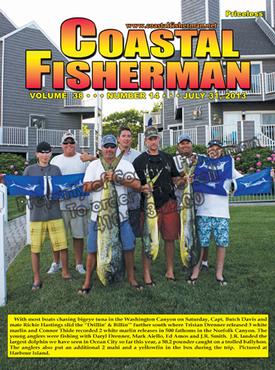


Article by Capt. Mark Sampson
 I guess it should only be expected that as the habits and life history of the different fish we pursue become better understood, the regulations that control their harvest will continue to be tweaked to best manage the special needs of every different fish, rather than just arbitrarily assigning a season, creel and size limits to a fishery and then hoping for the best. It’s a whole lot better for fishery managers to incorporate into a management plan regulations that correspond to fish migrations, spawning cycles, abundance and anything else that’s known to affect each individual species.
I guess it should only be expected that as the habits and life history of the different fish we pursue become better understood, the regulations that control their harvest will continue to be tweaked to best manage the special needs of every different fish, rather than just arbitrarily assigning a season, creel and size limits to a fishery and then hoping for the best. It’s a whole lot better for fishery managers to incorporate into a management plan regulations that correspond to fish migrations, spawning cycles, abundance and anything else that’s known to affect each individual species.
While there’s no doubt that this “species-specific” management (as the managers like to call it) is good for the resource, for us fishermen it’s becoming more than just a little bit of a problem trying to study, learn and keep track of what the regulations are on any given day, in any given location and for any given fish. Not to mention the fact that regulations can be changed right in the middle of the season. So it should not be surprising that, even though the laws might be based on good scientific data, some of the regulations might come off as being a bit confusing if not downright “wacky.”
Take bluefin tuna for instance; recreational anglers are allowed one bluefin per boat between 27 and less than 73-inches. However, recreational anglers fishing on a charter boat can land two, but one must be between 27 and less than 47-inches and the other must fall between 47 but less than 73-inches. At certain times, anglers may also land one bluefin per year over 73-inches. The opening and closing dates of this season varies a bit from year to year and much of it depends upon whether you’re fishing north or south of Great Egg Inlet in New Jersey. Landings of all bluefins must be reported by calling in to NMFS, unless you live in Maryland or North Carolina and then the fish must be tagged before they are removed from the boat.
If you think that tuna regulations are confusing, consider sharks. But first, before you go shark fishing you’d better brush up on your shark identification skills because you’re going to need them! Federal regulations allow anglers to keep one shark per boat, per day that has at a least 54-inch fork-length from the following group: shortfin mako, porbeagle, blue, oceanic whitetip, tiger, thresher, nurse, lemon, blacktip, spinner, bull, finetooth, hammerhead, and blacknose. However, until this past July 15th only makos, blue sharks and threshers were allowed to be kept in Virginia, Maryland, Delaware, and New Jersey. In addition to those sharks, anglers may keep one bonnethead or Atlantic sharpnose shark per person per day, but that’s year-round.
As if those shark regulations aren’t confusing enough, lets consider hammerheads and whitetips. If you have either of those species aboard your boat, you cannot land or posses any tunas, billfish or swordfish. Or, if you catch any of those fish first, you are prohibited from possessing any hammerheads. But wait, it gets better! Starting August 2nd, the recreational size limit for hammerheads will increase from 54 to 78-inches. So there’s going to be yet “another” size limit to remember.
How about black sea bass? In Maryland the recreational fishery opened May 20th, but it will close on October 14th (for 17 whole days) until November 1st when it will open back up and stay that way until the end of the year.
The tautog season is a little easier to remember because it’s open from January 1st until November 26. The “catch limit” is the confusing part because from January 1st until May 15th, anglers were allowed 4 tautog per person, but then on May 16th, it dropped to 2 per person and on November 1st it will go back up to 4 per person.
The red drum regulations aren’t too bad since the season is always open. However, they are a “slot-limit” fish so that there’s both a minimum size of 18-inches and a “maximum” size of 27-inches that can be kept. More numbers to remember.
Wouldn’t it be nice if all the regulations were as uncomplicated as those for the coastal striped bass fishery; two-fish per person, per day, all year. Simple! But as confusing as the recreational regulations can be, don’t make the mistake of complaining about it in front of any commercial fishermen, because if you think we have it bad, you don’t even want to know how many quirky regulations they have to contend with. They really have to put their study time in to stay in compliance!
I agree that fishery management plans should be as precise as possible so that they can best address the conservation needs of each particular species, and it should be up to us fishermen to pay attention, do our homework and keep up with whatever regulations we’re supposed to follow. But darn, this fishing thing is becoming one tough course to pass!
Captain Mark Sampson is an outdoor writer and captain of the charter boat “Fish Finder”, docked at the Ocean City Fishing Center.